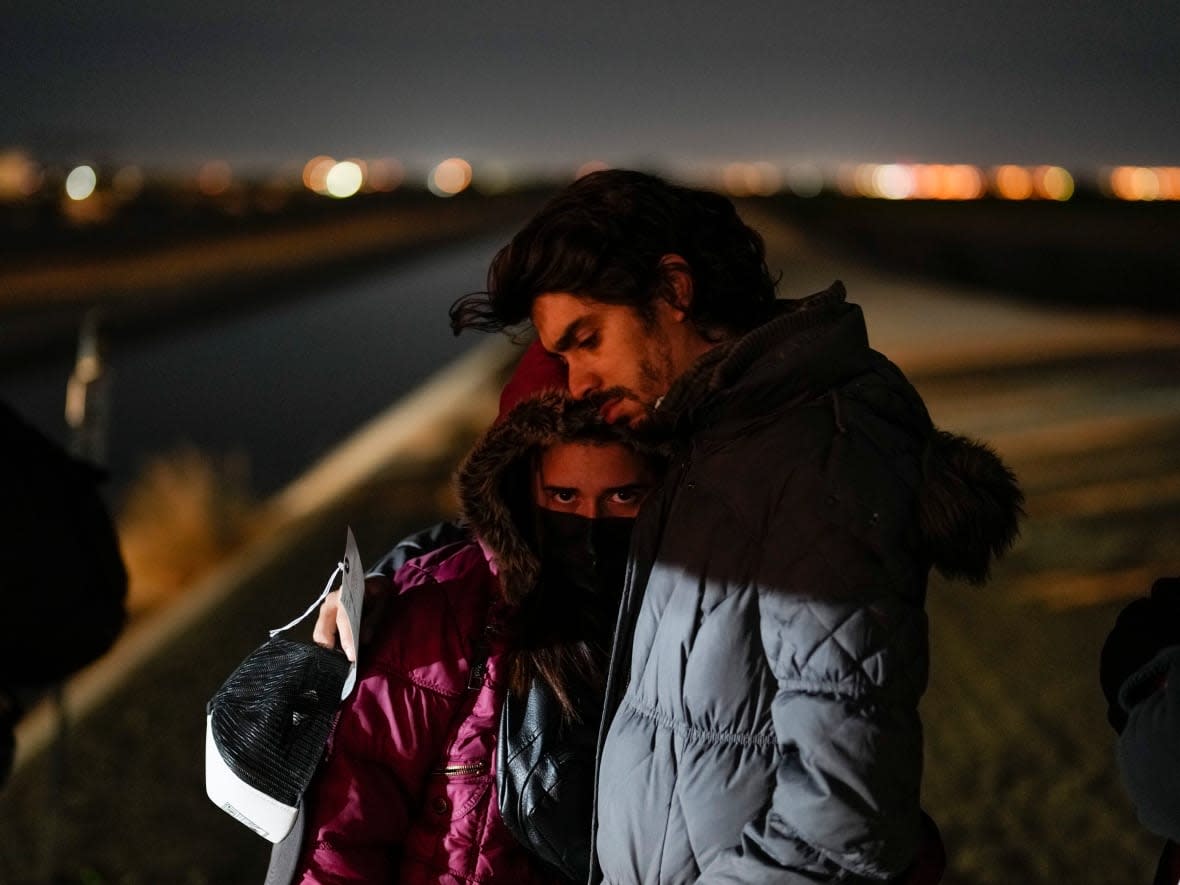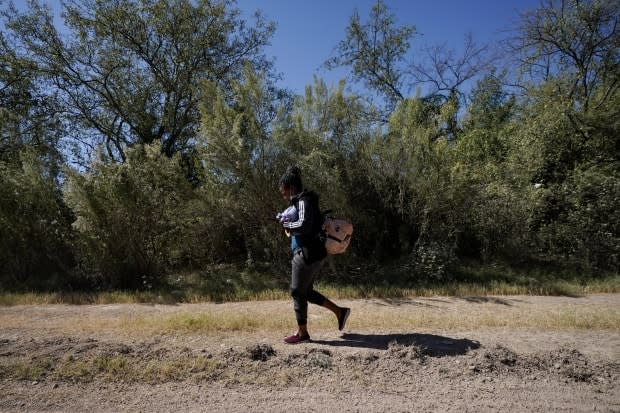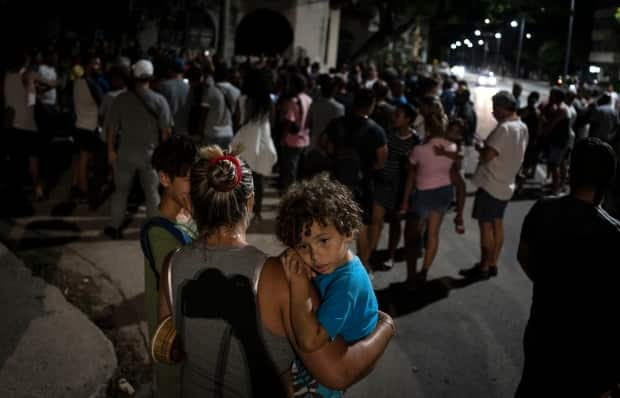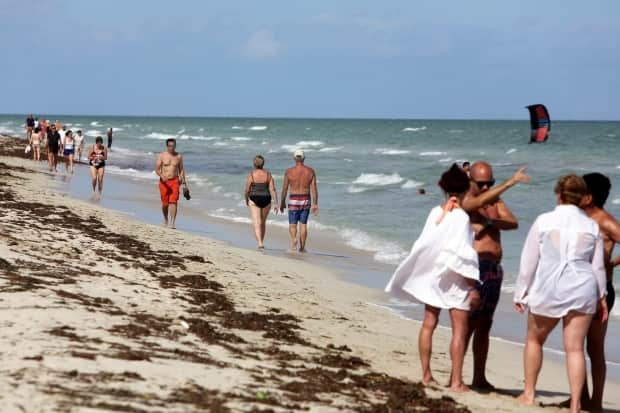As holidaying Canadians return to Cuba, Cubans themselves are fleeing in record numbers

Canadian tourists returned to Cuba in large numbers this winter after their numbers fell to almost nothing during the pandemic. Preliminary figures suggest that Canadians accounted for about 52 per cent of all foreign arrivals in Cuba in January.
Cubans themselves, meanwhile, are fleeing the island nation in record numbers in response to unprecedented levels of poverty and political repression.
More than 220,000 Cubans — amounting to 2 per cent of the island's entire population — were taken into custody after crossing the U.S.-Mexico border last year. Others settled in other countries in the Americas or traveled as far as Russia and Serbia (both countries that allow Cubans to enter visa-free).
Within the Cuban diaspora, there is a sense that the country is emptying out — that almost anyone who has the means to leave is either actively planning an escape or is at least thinking about it.
An industry has grown up around the exodus, with airlines cashing in on Cubans' desperation by charging exorbitant fares to destinations where Cubans are allowed to land.
And there are indications that the Cuban Communist Party and its ally in Nicaragua, the Ortega-Murillo regime, are allowing and even encouraging the exodus in order to kill two birds with one stone by generating income while removing dissidents.
'Everyone is leaving'
"This would be the largest single figure of people leaving the island ever registered, either before or after the revolution," said Jorge Duany, an expert on Cuban migration at Florida International University.
"It's more than (the Mariel boatlift) in 1980, the prior record, or the more recent upsurge in Cuban migration during the rafter crisis in 1994."
Duany said the exodus is being driven by a combination of factors, including political repression, a failing economy and "health issues, especially during the pandemic in the last few years."
"And all of these factors combined to create a perfect storm," he said. "So people are just desperate to leave, whether it's for immediate reasons like not having enough food on their table, or for having participated in one of the peaceful demonstrations, not just on July 11 (2021), but also smaller ones in the last year and a half, as well as the very extreme response by the Cuban government of repressing these protests and putting people in jail."
With its own economy a shambles, Cuba depends heavily on remittances sent by Cubans living in the U.S. The Trump administration imposed limits on how much could be sent and how, leading Western Union to close its operations in Cuba.
Last May, the Biden administration relaxed those rules and this month, Western Union resumed normal remittance operations. But Duany said the combination of the pandemic — which brought tourism almost to a standstill — and the difficulties around remittances pushed many Cubans to the point of desperation.
Duany said the exodus cuts across all segments of Cuban society.
"I think everyone is leaving," he said. "We don't have a good profile of the last wave of ... 2022, the 225,000 people yet, but previous data that we do have from Homeland Security suggests that it's a cross-section mostly of Cubans from all walks of life. They tend to be younger, of course."
'Families are selling everything they have'
Kirenia Carbonell is a Canadian federal public servant originally from the small town of La Canela in Cuba's eastern Holguin province.
"Where I come from," she told CBC News, "entire families are selling everything they have and they're leaving via Nicaragua. Some of them are even going to Suriname. I never heard of Suriname before. Some of them from my own family are living in Suriname. They find themselves a job and they're able to afford to sponsor the rest of the family from Cuba to Suriname."
Carbonell said inflation has widened the gap between Cuban wages and the cost of the most basic necessities to a point where many can no longer cope.
"We have that ration card that every month you are supposed to get from your local grocery this and that, five pounds of rice," she said. "This month in my municipality, they brought one pound of rice per person for the entire month. But then the same government has special stores where you can go and buy one pound for 150 pesos. They get paid 2,500 pesos on average and just the food for the month is over 30,000 pesos."
A new escape route opens
The stereotype of a Cuban migrant is the "balsero" or rafter who floats across the straits that divide Cuba from Florida.
That kind of migration is still happening. The U.S. Coast Guard detained about 2,500 balseros during January alone.
But these days, only the poorest and most desperate Cubans take the dangerous sea route.
New air and land routes have opened up that are preferred by migrants — and are also more lucrative for the Cuban government and its Nicaraguan ally.
Cuba has one of the world's weakest passports in terms of visa-free travel because of the well-known penchant of Cubans to defect once they leave the island. But in November 2021, Nicaragua lifted the visa requirement for Cuban citizens, ostensibly to promote tourism.

"They are lovers of our volcanoes. They don't have volcanoes," Ana Carolina Garcia of Nicaragua's tourism bureau said at the time.
In fact, the vast majority of Cubans who travel to Nicaragua subsequently head north and try to cross the U.S.-Mexico land border.
No sooner was the visa requirement lifted than a group of little-known charter airlines began to offer exorbitantly-priced flights from Havana or Camaguey, Cuba to Managua, Nicaragua. Carriers such as Air Century, Aruba Airlines and the Venezuelan state-owned Conviasa have charged up to $6,000 for seats on the two-hour flight.
Normally, Cubans can only pay those fares by borrowing money from relatives who have already left the island.
Regimes cashing in on migrants
The air migration represents a bonanza for both the Nicaraguan and Cuban regimes, which profit mightily from taxes, airport fees, landing fees and other charges.
If the migrants are successful in reaching the U.S., Cuba can expect them to send money to family members back home — at which point the regime profits a second time by taxing the remittances. (For Nicaragua too, remittances have become essential)
Cuban Communist authorities take a third cut when family members in Cuba have to spend those dollars in the Cuban government's monopolistic dollarized stores, which sell goods with an average mark-up of over 200 per cent.
(CBC News contacted the Cuban embassy for this article but did not receive a response.)
Moreover, dissidents say the Cuban and Nicaraguan regimes both see migration as achieving a double political purpose: expelling their own dissidents and frustrated citizens while undermining the United States with waves of illegal immigration.

"This is their modus operandi, every time the tensions in Cuba rise," said Carbonell, who linked the wave of protests that swept Cuba in the summer of 2021 directly to the decision to open the Nicaraguan escape valve in the fall of that year.
"It relieves the pressure by opening its borders, as in the Mariel situation (in 1980)," she said. "And in this case, they found an accomplice in Nicaragua who then was able to receive Cubans without the visa.
"Everyone knows where those Cubans are going to end up, whether it's in the United States or on a road into Quebec. They know they're not going to stay in Nicaragua."
Exporting people
"There seems to be some sort of agreement between the Nicaraguan government and the Cuban government in order to facilitate this migration," said Duany. "Although again, it's not in any document I've seen.
"But clearly the Cuban government benefits from exporting a large number of people, especially dissidents, but also those who can't find work in Cuba. And that seems to be a problem as well in the last few years, of an increasing unofficial unemployment. If you look at the numbers, Cuba has one of the lowest unemployment rates in the world, but many of those people aren't working productively and they're making very low salaries."
Remittances, he said, "have become probably the second or third major source of currency after tourism and the export of professional services (such as Cuban doctors).
"It's one of the ways in which the Cuban government can find a lifeline through this flow of money that eventually gets back to Cuba."
The other way the Cuban regime hopes to dig itself out of its current economic crisis is by doubling down on tourism.
"There's a lot of effort to re-establish Russian tourism," said Duany, adding the war in Ukraine likely will make it difficult to restore the Russian tourist traffic Cuba enjoyed before the pandemic.
Cuba depends more than ever on Canadians
Before the pandemic, the biggest source of tourist money for the Cuban regime was Canadians.
About 1.3 million Canadians would enter and leave Cuba in a typical year — more than any other nationality, including Cubans themselves.
The Cuban government and the Cuban military that owns many of the resorts have focused spending in recent years on building new hotels.
But although Canadians are now returning — Swoop, a low-cost airline, announced three new weekly flights to Varadero in January — tourism numbers have not rebounded as quickly as the Communist Party had hoped. January 2023 saw only about 63 per cent of the bookings reported in January 2020, although for Canadian tourists the number was closer to 80 per cent.

Cuba has had to halve its GDP growth forecast for 2023 from 6 per cent to 3 per cent as it struggles to recover from the 11 per cent plunge it suffered in 2020.
Cuban pro-democracy activists continue to appeal to Canadians not to travel to Cuba.
"I believe there is a lack of awareness that these things are going on in Cuba," said Carbonell. "I have many friends who are even now going to go because in their minds, when they go, they help the Cuban population.
"And it's true, they bring a luggage full of medicine, full of essentials, nylons for the ladies working at the resort and so forth, because they know there is nothing. But maybe they don't realize that you can contribute all you want to your friends in Cuba, but you nevertheless are contributing to the regime."
Carbonell said the money the Cuban regime and armed forces obtain from tourism is mostly re-invested in building new hotels, while the Cuban workforce is paid only a fraction of what hotel workers are paid in neighbouring countries. The money also finances the Cuban Communist Party's apparatus of repression.
"No one who goes to the resort can imagine that beyond those walls, people are suffering so badly," she said.
Although the new routes out of Cuba may seem safer than venturing onto the sea in rickety rafts, hundreds of Cubans have lost their lives or disappeared in the recent wave of departures. Some died of accidents or homicides on the overland route, or drowned trying to cross the Rio Grande.
"People have lost their lives in the rivers, people have lost their lives on the sea," said Carbonell.
"So how desperate they could be? And the government took advantage of that, just took advantage of everyone who had someone abroad who could send them the money to do that, of everyone who sold every little thing they had to be able to collect the money and do the route."


